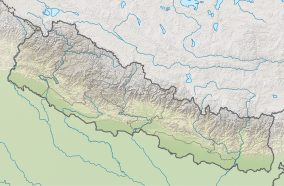|
Parsa National Park
Parsa National Park is a national park in the Terai of south-central Nepal covering an area of 627.39 km2 (242.24 sq mi) in the Parsa, Makwanpur and Bara Districts and ranging in elevation from 435 to 950 m (1,427 to 3,117 ft) in the Sivalik Hills. It was established as a wildlife reserve in 1984 and received national park status in 2017. It is surrounded by a buffer zone since 2005 with an area of 285.3 km2 (110.2 sq mi).[1] In 2015, the protected area was further extended by 49 sq mi (128 km2).[2] To the north of Parsa National Park, the East Rapti River and Sivalik Hills form a natural boundary to human settlements. To the east, the boundary extends up to the Hetauda–Birgunj highway; to the south, a forest road demarcates the park's boundary. To the west is Chitwan National Park, which is situated just north of Valmiki National Park, a tiger reserve in India. Thus, this transnational protected area of 2,075 km2 (801 sq mi) represents the Tiger Conservation Unit (TCU) Chitwan–Parsa–Valmiki, which covers a total of 3,549 km2 (1,370 sq mi) in the Terai–Duar savanna and grasslands.[3] Before being converted to a protected area, the region was a private game reserve and hunting park for both the British and Nepalese elite.[1][4] VegetationThe typical vegetation in the park consists of sal forest constituting about 90% of the area. Chir pine grows in the Churia Hills; Khair, sissoo and silk cotton trees occur along watercourses. Sabai grass grows well on the southern face of the Churia Hills.[4] An estimated 919 floral species have been recorded including 298 vascular plants, 234 dicots, 58 monocots, five pteridophytes, and one gymnosperm.[1] FaunaA census conducted in May 2008 confirmed the presence of 37 gaurs.[5] Four adult Bengal tigers were estimated to be resident in the Parsa National Park in 2008.[6] A three-month camera trapping survey in February 2017 revealed the presence of 19 Bengal tigers, indicating a substantial increase of the population.[7] As of 2015, three Indian rhinoceros have been recorded in the national park.[8] Reptiles present include the mugger crocodile, king cobra, monocled cobra, Russell's viperr, elongated tortoise, Indian softshell turtle, Indian black turtle, Indian flapshell turtle, Oriental garden lizard and Oriental rat snake.[9] References
External links |
||||||||||||||||||||||


